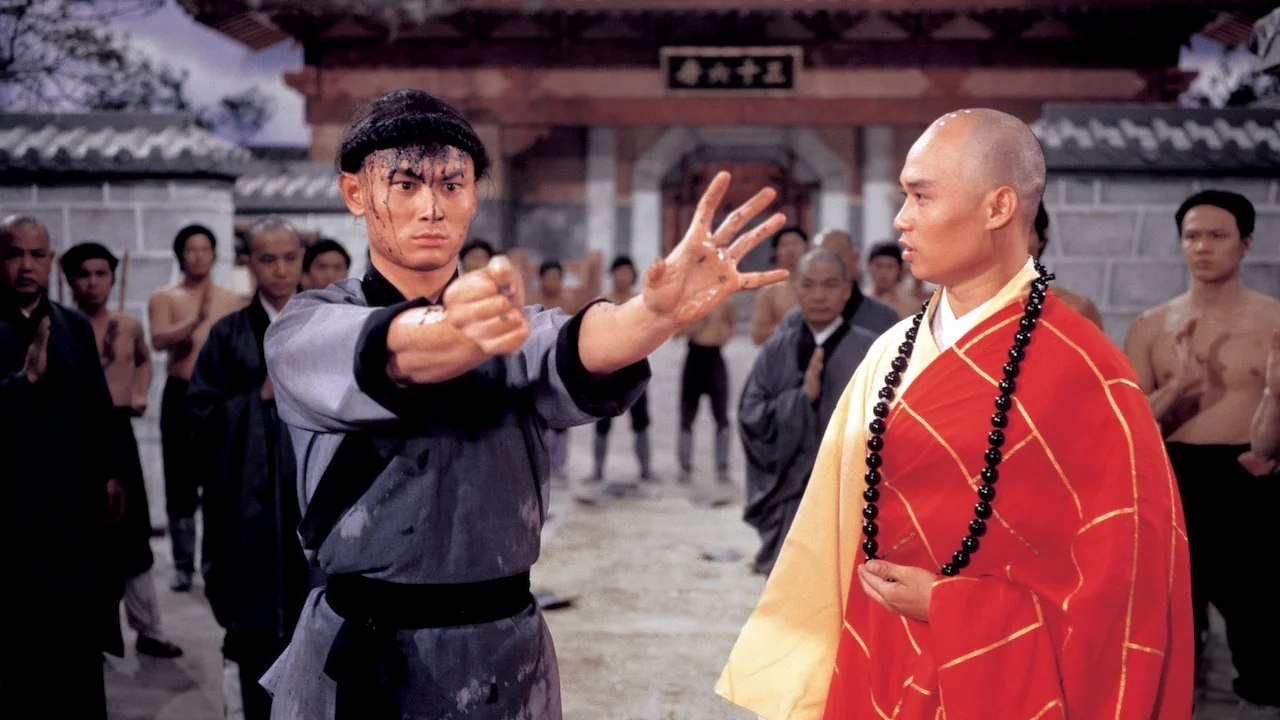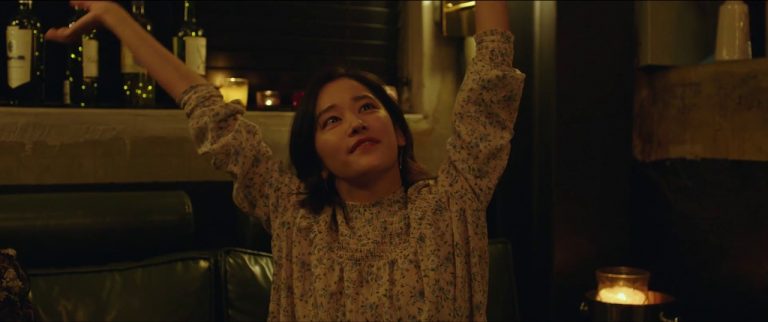One could almost mistake the sequel to the iconic “The 36th Chamber of Shaolin” as a parody if it weren’t made by the same people. This film is emblematic of Lau Kar-leung’s further push into comedic territory during his later output for Shaw Brothers Studio before they shut down. There is a sense of confusion about the film’s continuity; it opens on a credits sequence with star Gordon Liu employing his martial arts at the Shaolin temple. As we soon come to learn, the story this time is a bit different, although the acting stays on the same beats as the original, just pared down in scale.
A microcosm of the larger conflict displayed in the previous film, we begin on a Fabric Dyeing Mill that Manchu overlords raid. They act as mercenaries to watch over the working conditions of their boss Wang (Wang Lung-wei). Desperate to get their wages back and come out from the iron fist rule of their new bosses, the workers led by the silly Ah Chao (Hsiao Ho) hire an actor to play Monk San Te and scare the villains with his Kung-fu. Chu Jen-chieh (Gordon Liu) is the actor in question, a con man who impersonates Shaolin Monks for donations. The film is littered with a bit of self-aware humor, as Liu plays a character tasked to impersonate his role from the first film. Confusingly enough, the film also has a real San Te played by an entirely different actor.
The ploy doesn’t matter much as the workers are found out easily and terribly beaten for their insolence, forcing Chu to run for his life. Writers Ni Kuang and Lau Kar-leung pretty much chart the same emotional beats as the original film, setting them in a different context. The ordeal emotionally breaks Chu, and his actions cause suffering to the others. Chu heads to the Shaolin Temple to learn kung fu, like Liu’s protagonist in the first film, determined to get revenge.
Where this film truly differs is the comedic tone. The emotional breakdown of the workers never threatens to cross into real danger. Even Chu’s heroic quest never alters the character, allowing Liu to flex even more of his acting muscles in this sequel as a bumbling oaf. Chu is out of his depth trying to become a Shaolin monk, and he knows this. In the “36th Chamber of the Shaolin,” the second act was about the hero running the gauntlet of Shaolin chambers. Here, it is about Chu attempting to sneak into the temple itself. It becomes easier said than done, as the Monks consistently thwart his attempts, with the chambers tasks acting as barriers.
Ironically, the protagonist finds support in Monk San Te (this time portrayed by King Chu Lee), who allows him to stay. San Te acts the fool, letting Chu get up to his usual con-man tricks while fooling him into menial tasks for the Temple. Ultimately, Chu is determined to learn Kung-fu, but instead, San Te has him build the scaffolding to renovate the temple. This allows Chu a unique vantage point from which to view the Kung-fu training occurring within the 36th chamber run by San Te.
As the role-playing Chu does, the film’s approach to martial arts training takes on an absurdly comedic tonality. In order to follow the training while accomplishing his odd tasks, Chu utilizes Kung-fu until San Te banishes him from the temple. That repetition follows suit in the third act when Chu returns to his village. He is unaware that his construction work has enabled him to master kung fu just as San Te planned. On the surface, it seems that the screenplay is a redundant, lazy reworking of the original film.

However, the decision to treat this more like a comedy gives it a new layer of dynamism. This rings absolutely true for the quirky fight sequences. It takes a while for Lau Kar-leung to showcase his specialty, but when the climactic fight sequence begins, the wait is totally worth it. Gordon Liu has fun with these scenes, showcasing a different style as he applies his skills according to the plot. Much like the previous film, there’s no need to cut back to the training and pander to the audience. When Chu uses bamboo weapons and ropes to bind his foes and the goons together, beating them defensively, it’s easy to understand how scaffolding made him a master.
The camera work here is also fascinating, especially once Chu lures the remaining villains and their leader Wang into an abandoned construction site for a temple. The close-ups and two shots create excitement as the camera swivels close to witness Liu’s unique fighting style. It is the long shots that form an incredible visual subtext; the language of the filmmaking is consistent across the board.
As his work is complete, Chu, like a fool, scales the temple roof, celebrating, viewed afar by the scaffolding work itself. The long shots use settings and items to display Chu’s relation to his growth as a character and their importance in his narrative. The mill’s water wheel finally gushes with water when Chu takes out the workers’ oppressors. Similarly, the final fight is witnessed by a grand statue of Buddha, Chu ultimately earning the respect and status as a Monk.
Vital scenes beyond the Kung-fu are rife with this deeper subtext. Even with a comedic tone, Lau Kar-leung understands the message of empowerment in the series. When broken by his actions in the first act, it is in a narrow alleyway that Liu’s Chu is urged to learn Kung-fu. When confronting Monk San Te at the temple, it is in a similar alley of the temple that he displays his willingness to learn. Finally, it is in a similar alley where Chu defeats Boss Wang with his eccentric style of fighting.
That peculiarity stretches further into the craft of the film, even when one can tell how cheap the film looks compared to the original. The training to enter the chamber includes structures and designs different from the first film, with Chu only visiting one chamber as opposed to the original 35. The editing in this scenario isn’t as strong, yet the low guitar strumming of the score is far more effective. Coupled with the cliché comedic sound effects, the music and sound design of the film enhance the comedic aspect that Lau Kar-leung is creating.
Viewed in comparison to the original and influential masterpiece, it’s easy to be dismissive of “Return to the 36th Chamber” as a film. When the viewer sees this as a separate film, it becomes far more enjoyable. It is a reminder that if one can’t better a sequel, then it is better to be different, at least.



![Hypochondriac [2022]: ‘Fantasia’ Review: This visceral, authentic fever dream is a must-watch](https://79468c92.delivery.rocketcdn.me/wp-content/uploads/2022/07/Hypochondriac-768x320.jpg)



